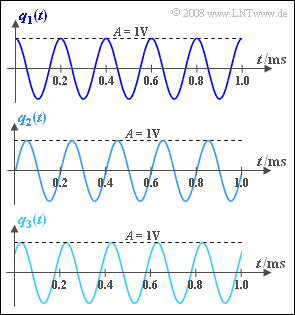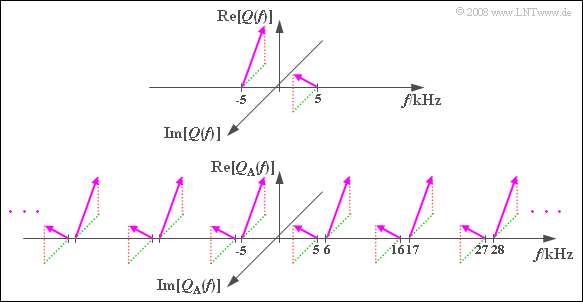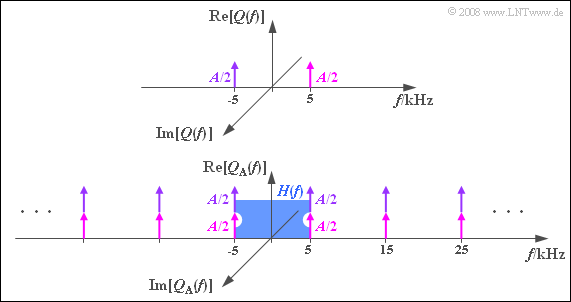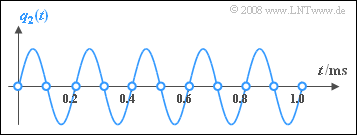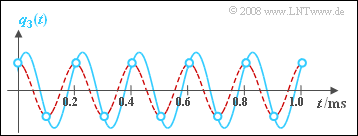Exercise 4.2Z: About the Sampling Theorem
The sampling theorem states that the sampling frequency fA=1/TA must be at least twice as large as the largest frequency fN, max contained in the source signal q(t):
- fA≥2⋅fN,max⇒TA≤12⋅fN,max.
If this condition is met, then at the receiver the message signal can be passed through a rectangular (ideal) low-pass filter with frequency response
- H(f)={11/20f¨urf¨urf¨ur|f|<fG,|f|=fG,|f|>fG
can be completely reconstructed, that is, it is then v(t)=q(t).
- The cutoff frequency fG is to be chosen equal to half the sampling frequency.
- The equal sign is generally valid only if the spectrum Q(f) does not contain a discrete spectral line at frequency fN, max.
In this exercise, three different source signals are considered, each of which can be expressed as a harmonic oscillation
- q(t)=A⋅cos(2π⋅fN⋅t−φ)
with amplitude A=1 V and frequency fN=5 kHz. For the spectral function Q(f) of all represented time signals generally holds:
- Q(f)=A2⋅δ(f−fN)⋅e−j⋅φ+A2⋅δ(f+fN)⋅e+j⋅φ.
The oscillations sketched in the graph differ only by the phase φ:
- φ_1 = 0 ⇒ cosine signal q_1(t),
- φ_2 = π/2 \ (= 90^\circ) ⇒ sinusoidal signal q_2(t),
- φ_3 = π/4 \ (= 45^\circ) ⇒ signal q_3(t).
Hints:
- The exercise belongs to the chapter "Pulse Code Modulation".
- Reference is made in particular to the page "Sampling and Signal Reconstruction".
- The sampled source signal is denoted by q_{\rm A}(t) and its spectral function by Q_{\rm A}(f).
- Sampling is always performed at ν \cdot T_{\rm A}.
Questions
Solution
- The sampling theorem is satisfied by f_{\rm A} = 11 \ \rm kHz > 2 \cdot 5 \ \rm kHz so that a complete signal reconstruction is always possible.
- The spectrum Q_{\rm A}(f) results from Q(f) by periodic continuation at the respective frequency spacing f_{\rm A}, which is generally illustrated in the graph.
- By a rectangular low-pass with f_{\rm G} = f_{\rm A}/2 = 5.5 \ \rm kHz the original spectrum Q(f) is obtained.
The shift by
- f_{\rm A} = 11 \ \rm kHz yields the lines at +6 \ \rm kHz and +16 \ \rm kHz,
- -f_{\rm A} = -11 \ \rm kHz yields the lines at -6 \ \rm kHz and -16 \ \rm kHz,
- 2 - f_{\rm A} = 22 \ \rm kHz yields the lines at +17 \ \rm kHz and +27 \ \rm kHz,
- -2 - f_{\rm A}= -22 \ \rm kHz yields the lines at -17 \ \rm kHz, -27 \ \rm kHz.
(2) The sampling distance is equal to the reciprocal of the sampling frequency:
- T_{\rm A} = {1}/{f_{\rm A} }\hspace{0.15cm}\underline { = 0.1\,{\rm ms}} \hspace{0.05cm}.
(3) The correct solution is suggestion 2:
- For the cosinusoidal signal, according to this graph with f_{\rm A} = 10 \rm \ kHz: All spectral lines of Q_{\rm A}(f): are real.
- The periodization of Q(f) with f_{\rm A} = 10 \rm \ kHz leads to a Dirac comb with spectral lines at ±f_{\rm N}, ±f_{\rm N}± f_{\rm A}, ±f_{\rm N}± 2f_{\rm A}, . ..
- Through the superpositions, all Dirac functions have weight A, while the spectral lines of Q(f) are weighted only by A/2 each.
- Because H(f = f_{\rm N}) = H(f = f_{\rm G}) = 0.5 the spectrum V_1(f) after the low-pass is identical to Q_1(f) ⇒ v_1(t) = q_1(t).
- In the time domain, the signal reconstruction can be thought of as follows: The samples of q_1(t) lie exactly at the signal maxima and minima.
- The lowpass filter forms the cosine signal with correct amplitude, frequency and phase.
(4) Correct is suggested solution 2:
- All sampled values of q_2(t) now lie exactly at the zero crossings of the sinusoidal signal, which means that here q_{\rm A}(t) \equiv 0 holds. However, this naturally also gives v_2(t) \equiv 0.
- In the spectral domain, the result can be derived using the graph for subtask (1).
⇒ Q(f) is purely imaginary and the imaginary parts at ±f_{\rm N} have different signs. - Thus, one positive and one negative part cancel each other in periodization
⇒ Q_{\rm A}(f) \equiv 0 ⇒ V_2(f) \equiv 0.
(5) None of the given solutions is correct:
- If in the graph for the subtask (1) the sampling frequency f_{\rm A} = 11 \ \rm kHz is replaced by f_{\rm A} = 10 \ \rm kHz, the real parts add up, but the imaginary parts cancel out.
- This means that now Q_{\rm A}(f) and V_3(f) are real spectra. This further means:
- The phase information is lost (φ = 0) and the output signal v_3(t) is a cosine signal.
- q_3(t) and v_3(t) thus differ in both amplitude and phase. Only the frequency remains the same.
The graph shows
- turquoise the signal q_3(t) and its samples (circles), and
- red dashed the output signal v_3(t) of the low-pass.
You can see that the low-pass gives exactly the result you would probably choose if you were to draw a curve through the samples (circles).
